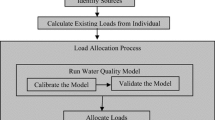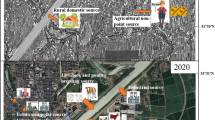Abstract
A common land and water management task is to determine where and by how much source loadings need to change to meet water quality limits in receiving environments. This paper addresses the problem of quantifying changes in loading when limits are specified in many locations in a large and spatially heterogeneous catchment, accounting for cumulative downstream impacts. Current approaches to this problem tend to use either scenario analysis or optimization, which suffer from difficulties of generating scenarios that meet the limits, or high complexity of optimization approaches. In contrast, we present a novel method in which simple catchment models, load limits, upstream/downstream spatial relationships and spatial allocation rules are combined to arrive at source load changes. The process iteratively establishes the critical location (river segment or lake) where the limits are most constraining, and then adjusts sources upstream of the critical location to meet the limit at that location. The method is demonstrated with application to New Zealand (268,000 km2) for nutrients and the microbial indicator E. coli, which was conducted to support policy development regarding water quality limits. The model provided useful insights, such as a source load excess (the need for source load reduction) even after mitigation measures are introduced in order to comply with E. coli limits. On the other hand, there was headroom (ability to increase source loading) for nutrients. The method enables assessment of the necessary source load reductions to achieve water quality limits over broad areas such as large catchments or whole regions.







Similar content being viewed by others

References
Afshar, A, Masoumi, F (2016) Waste load reallocation in river-reservoir systems: simulation-optimization approach. Environ Earth Sci 75:53
Alexander RB, Smith RA, Schwarz GE (2004) Estimates of diffuse pollution sources in surface waters of the United States using a spatially referenced watershed model. Water Sci Technol 49:1–10
Doole GJ (2015) A flexible framework for environmental policy assessment at the catchment level. Comput Electron Agric 114:221–230
Doole GJ, Marsh DK (2014) Methodological limitations in the evaluation of policies to reduce nitrate leaching from New Zealand agriculture. Aust J Agric Resour Econ 58:78–89
Elliott A, Alexander R, Schwarz G, Shankar U, Sukias J, McBride G (2005) Estimation of nutrient sources and transport for New Zealand using the hybrid mechanistic-statistical model SPARROW. J Hydrol (NZ) 44:1–27
Elliott AH, Semadeni-Davies AF, Shankar U, Zeldis JR, Wheeler DM, Plew DR, Rys GJ, Harris SR (2016a) A national-scale GIS-based system for modelling impacts of land use on water quality. Environ Model Softw 86:131–144
Elliott S, Wadhwa S, Whitehead A, Snelder T, Muirhead R, Monaghan R (2016b) Modelling national land-use capacity. Exploring bottom lines and headroom under the NPS-FM 2014. Update Report. October 2016. National Institute of Water and Atmospheric Research, Hamilton, New Zealand
Evans JR, Minieka E, Minieka E (1992) Optimization algorithms for networks and graphs, 2nd edn. M. Dekker, New York
Fu BH, Merritt WS, Croke BFW, Weber TR, Jakeman AJ (2019) A review of catchment-scale water quality and erosion models and a synthesis of future prospects. Environ Model Softw 114:75–97
Hashemi F, Olesen JE, Dalgaard T, Børgesen CD (2016) Review of scenario analyses to reduce agricultural nitrogen and phosphorus loading to the aquatic environment. Sci Total Environ 573:608–626
Hering D, Borja A, Carstensen J, Carvalho L, Elliott M, Feld CK, Heiskanen A-S, Johnson RK, Moe J, Pont D (2010) The European Water Framework Directive at the age of 10: a critical review of the achievements with recommendations for the future. Sci Total Environ 408:4007–4019
Keller AA, Fournier E, Fox J (2015) Minimizing impacts of land use change on ecosystem services using multi-criteria heuristic analysis. J Environ Manag 156:23–30
Limbrunner JF, Vogel RM, Chapra SC, Kirshen PH (2013) Classic optimization techniques applied to stormwater and nonpoint source pollution management at the watershed scale. J Water Resour Plan Manag 139:486–491
Linker LC, Batiuk RA, Shenk GW, Cerco CF (2013) Development of the chesapeake bay watershed total maximum daily load allocation. J Am Water Resour Assoc 49:986–1006
Lynn IH, Manderson AK, Page MJ, Harmsworth GR, Eyles GO, Douglas GB, Mackay AD, Newsome PJF (2009) Land Use Capability Survey Handbook - a New Zealand handbook for the classification of land, 3rd edn. Agresearch, Landcare Research, GNS Science, Hamilton, Lincoln, and Lower Hutt, New Zealand
Matthews KB, Sibbald AR, Craw S (1999) Implementation of a spatial decision support system for rural land use planning: integrating geographic information system and environmental models with search and optimisation algorithms. Comput Electron Agric 23:9–26
New Zealand Government (2014) National Policy Statement for Freshwater Management 2014. New Zealand Government, Ministry for the Environment Publication Number ME 1155. New Zealand Government, Wellington, New Zealand
New Zealand Government (2017) National Policy Statement for Freshwater Management 2014. Updated August 2017 to incorporate amemdments from the National Policy Statement for Freshwater Amendment Order 2017. New Zealand Government. New Zealand Government, Wellington
Oehler, F, Elliott, AH (2011) Predicting stream N and P concentrations from loads and catchment characteristics at regional scale: a concentration ratio method. Sci Total Environ 409:5392–5402
Parliamentary Commissioner for the Environment (2014) Water quality in New Zealand: land use and nutrient pollution. Wellington, New Zealand
Pearl J (1984) Heuristics: intelligent search strategies for computer problem solving. Addison-Wesley Longman Publishing Company, Boston, MA, USA
Pistocchi A, Udias A, Grizzetti B, Gelati E, Koundouri P, Ludwig R, Papandreou A, Souliotis I (2017) An integrated assessment framework for the analysis of multiple pressures in aquatic ecosystems and the appraisal of management options. Sci Total Environ 575:1477–1488
Rodriguez, HG, Popp, J, Maringanti, C, Chaubey, I (2011) Selection and placement of best management practices used to reduce water quality degradation in Lincoln Lake watershed. Water Resour Res 47(1): https://doi.org/10.1029/2009wr008549
Selbie, D, Watkins, N, Wheeler, D, Shepherd, M (2013) Understanding the distribution and fate of nitrogen and phosphorus in OVERSEER®, Proceedings of the New Zealand Grassland Association, vol. 75. New Zealand Grasslands Association, pp. 113–117
Snelder T, Biggs B, Weatherhead M (2010) New Zealand River Environment Classification User Guide. March 2004 (Updated June 2010) ME Number 499. Ministry for the Environment, Wellington, New Zealand
Su Y, Li KQ, Liang SK, Lu S, Wang Y, Dai AQ, Li YB, Ding DS, Wang XL (2019) Improved simulation-optimization approach for identifying critical and developable pollution source regions and critical migration processes for pollutant load allocation. Sci Total Environ 646:1336–1348
Tsakiris G, Alexakis D (2012) Water quality models: an overview. Eur Water 37:33–46
United States Environmental Protection Agency (1999) Draft guidance for water quality-based decisions: the TMDL process. EPA, 2nd Edn. U.S. Environmental Protection Agency, Washington, D.C, 841-D-99-001
White DA, Smith RA, Price CV, Alexander RB, Robinson KW (1992) A spatial model to aggregate point-source and nonpoint-source water-quality data for large areas. Comput Geosci 18:1055–1073
Yang GX, Best EPH (2015) Spatial optimization of watershed management practices for nitrogen load reduction using a modeling-optimization framework. J Environ Manag 161:252–260
Zhang K, Chui TFM (2018) A comprehensive review of spatial allocation of LID-BMP-GI practices: Strategies and optimization tools. Sci Total Environ 621:915–929
Acknowledgements
This work was supported by the New Zealand Ministry for the Environment (Contract 21475); the Sources and Flows programme of the Ministry of Business, Innovation & Employment Our Land and Water Science Challenge; and the National Institute of Water and Atmospheric Research Strategic Science Investment Fund (Project FWWQ1907). We would also like to thank the Ministry for Primary Industries for making land use data available for use in this study. The opinions, findings, conclusions or recommendations expressed in this article are those of the authors and do not necessarily reflect the view or policy position of any New Zealand government agency.
Author information
Authors and Affiliations
Corresponding author
Ethics declarations
Conflict of interest
The authors declare that they have no conflict of interest.
Additional information
Publisher’s note Springer Nature remains neutral with regard to jurisdictional claims in published maps and institutional affiliations.
Supplementary information
Rights and permissions
About this article
Cite this article
Elliott, A.H., Snelder, T.H., Muirhead, R.W. et al. A Heuristic Method for Determining Changes of Source Loads to Comply with Water Quality Limits in Catchments. Environmental Management 65, 272–285 (2020). https://doi.org/10.1007/s00267-019-01235-x
Received:
Accepted:
Published:
Issue Date:
DOI: https://doi.org/10.1007/s00267-019-01235-x



